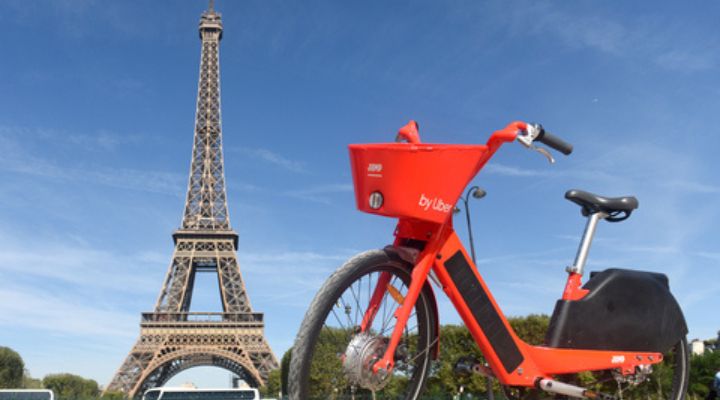Loading component...
Get up to speed on the mobility industry - our newsletter straight to your inbox!
Get up to speed on the mobility industry - our newsletter straight to your inbox!
Transport strategist Giles Bailey has first-hand experience of how a micromobility operator can co-exist within the ecosystem of a city authority – but what’s the secret to a successful partnership?
If any mode of the 21st century “connected mobility” discussion could be justifiably described as divisive then there would be a strong case for micromobility, and e-scooters in particular.
As a example of the opinion that they divide, the aforementioned e-scooters are popular on the streets of many a city in Europe but are entirely illegal in London (except for authorised, government-sponsored shared device trials) where one can only own and ride such a vehicle in the privacy of your own ‘land’.
So on the one hand the concept of shared personal modes of transport has many advantages (far too many to casually mention here). On the other hand it could be argued that the general European public’s perception of micromobility is clouded by regular sightings of abandoned, branded e-bikes strewn all over the pavement like a scene from a zombie movie. So how do private micromobility providers and cities work together in order to get a shared mobility scheme off the ground?
In terms of policy, micromobility operators have to (not quite literally) jump through any number of hoops in order to get the green light to implement a citywide trial. Transport strategist Giles Bailey has first hand experience of what has to be considered before potential operators get as far as pitching the project to a city?
In terms of policy, micromobility operators have to (not quite literally) jump through any number of hoops in order to get the green light to implement a citywide trial
“There are some very interesting issues. The field is still evolving quite rapidly for a whole host of reasons and it varies quite substantially from country to country within Europe as there clearly was a trend towards e-scooters,” he begins.
“There’s actually been a bit of a rollback on that, as we’ve seen in Paris, where the city banned the shared operators. But to get to the heart of your question, the city authority really needs to decide what it wants from a quite strategic, operational level and how that fits in with their strategies around public transport and the use of road space within the city.” 
Many facets of this can be found in a Sustainable Urban Mobility Plan (SUMP), but Bailey insists that there is one critical issue that is not covered by a traditional SUMP and that's the level of control and management that the city wants to put into the process.
“Cities tend to feel that they'd like a more open ecosystem where operators can arrive and experiment and deploy fleets and instil a more or less fair attitude to how e- scooters would operate. This is still being debated within the industry and within cities,” he adds. “Some cities believe that the process must be tightly managed and structured, with very specific numbers of vehicles and specific locations on a rotating contract.
Cities tend to feel that they'd like a more open ecosystem where operators can arrive and experiment and deploy fleets and instil a more or less fair attitude to how e- scooters would operate
“However,” he continues, “sometimes authorities just say ‘welcome to our city, come and a have a go’. Neither is right or wrong but I would say that I naturally drift towards the element of control, so that it can fit in with the more managed views of the mobility plan.”
Another contributory factor is the population and physical size of the city. For municipalities of over half a million people it is quite feasible to engage with multiple operators because there's an underlying level of demand.
“If you're a much smaller city,” says Bailey, “maybe a tourist location or a university town, you're much less likely to get multiple operators because the business model is much weaker, while you take the view of allowing whoever wants to come, but again, you could be too small to engage with operators and so might have to drift back to a much more manageable approach.”
From a micromobility operator's perspective, what are the regulations that have to be met and fulfilled? Are there some that they dread? Are there certain things that will just put them off from even applying on the grounds that the conditions aren’t conducive to a successful trial, let alone a marketing campaign trumpeting ta widespread implementation? 
It might be that the city is very tentative about a long-term deal, but the constant talk of needing a new tender is not very appealing to operators
Bailey stifles a laugh. “There’s actually a whole range and I’m not going to list them all, but if I can identify two of them, let's go with the ‘dread’ element first. Very short-term contracts are the issue. It just creates unnecessary bureaucracy and an ongoing instability for the operator. It might be that the city is very tentative about a long-term deal, but the constant talk of needing a new tender is not very appealing to operators.”
Any discussion or article about micromobility is unlikely to get to a point further than this without the subject of revenue and fees rearing its aesthetically displeasing head. Cities view micromobility schemes as a way of raising revenue and/or as a way of providing additional mobility options in the city, as London-based Canadian Bailey agrees.
“At times the notion of raising revenue is an onerous task for cities, with the needs for deposits and fees per vehicle. Clearly a lot of money from the operators comes to the city, and the city may be very attractive due to its size, but it can just make it very difficult for the operator to make money and not lose tremendous amounts if the fee structure is wholly unworkable.”
On to the second of Bailey’s two aforementioned regulatory sticking points: economy of scale.
“The issue here is slightly unrealistic control on the numbers of vehicles, or multiple operators with very, very low numbers of vehicles where there just is no scale,” he bemoans. “Maybe it's a very restricted area with very few vehicles which would mean not really running a viable service and certainly not making any money. But from the positive side, the consensus seems to be, particularly for slightly larger cities, to have multiple operators. So not just on an element of competition, but frankly, an element of variety, and gives the city some ability to experiment with different operators and see how the service could run in different ways.”
Cities need an element of competition, but frankly, an element of variety that gives them the ability to experiment with different operators and see how the service could run in different ways
Most micromobility providers feel that to have a few operators in the city, and not solely them, is a relatively reasonable compromise, adds Bailey.
“They would, but it's only good if the numbers are there, the scale is there and the flexibility is there. The overarching thing, though, is an ongoing conversation between the operator and the city authority. It’s where they learn, experiment and develop the scheme throughout its flexible implementation phase and early delivery phase rather than adopt a confrontational approach. 
Another thorny topic is the provision (or lack thereof) of space, dedicated or otherwise, that a city can feasibly give to a shared e-scooter or e-bike project. This is particularly relevant in Europe where city space is often at a premium, in every sense of the word.
Bailey’s expression suddenly transforms into one of deep-seated concern.
“Now you’ve touched on a topic that's very close to my heart in terms of frustration,” retorts the keen cyclist. “If you want to have micromobility working in your city you need to persuade people to use it. That’s clear but even after you have done that you have to provide them with space to use them. You can’t expect people riding unfamiliar e-bikes or e-scooters to fight it out for road space with the car, bus and truck traffic. Good luck to you, is all I can say.”
You can’t expect people riding unfamiliar e-bikes or e-scooters to fight it out for road space with the car, bus and truck traffic. Good luck to you, is all I can say
Bailey argues that for such a project to be successful it needs to provide potential customers with a robust, not necessarily dedicated but clearly defined micromobility network.
“We need to move away from the idea of bicycle lanes and give thought to a micromobility network that can deal with scooters and bicycles and the ever-evolving series of devices which inevitably will come to our cities. That network needs to be comprehensive -there's no value in just doing this in the city centre.”
You also need provision for the cars that can't use that space to go somewhere else, Intertraffic suggests.
“At the top of the list of priorities, I would argue, are pedestrians... then it's buses and the rest of the public transport network, and then delivery vehicles. Put into a European context, there clearly is not going to be space for everyone. The notion of being able to park your car in front of your house or get everywhere you need to go s in your car at the expense of everybody else in the chain is simply unworkable. Cars will have to be de-prioritised and space will have to be given to these other worthy causes - again not just in the centres of large parts to allow decarbonisation of the transport system.” Bailey finished on an enthusiastically positive note. “It’s obviously not an easy thing to do, but I would argue it’s essential and pleasingly many cities are making fantastic progress in this transformation.”
Often there is no plan that a city couldn't couldn't turn down for a whole host of reasons. But I think that goes back to understanding what the city wants and establishing what it’s trying to achieve
Lastly, what advice would Giles Bailey offer to an operator who is thinking of approaching some European cities with an e-scooter rental scheme, How defined a plan does an operator take to a city that the authority would find almost impossible to refuse?
“Often there is no plan that a city couldn't couldn't turn down for a whole host of reasons. But I think that goes back to understanding what the city wants and establishing what it’s trying to achieve from the scheme and actually have that conversation, rather than an operator tell the city what it’s going to do, or at least try to do. There's some cities where it's working. Oslo and Stockholm are examples of where micromobility is clearly fulfilling substantial user need. To circle back to the question, there are places where it's working well, but whether that can simply be transferred to another city is questionable.” Bailey concludes: “Any scheme has to provide incentives and investment for parking the vehicles to make it workable in the city.”
Giles K Bailey is managing director of Stratageeb Ltd, based in London, and has several years’ experience working in the micromobility sector from the operator’s perspective